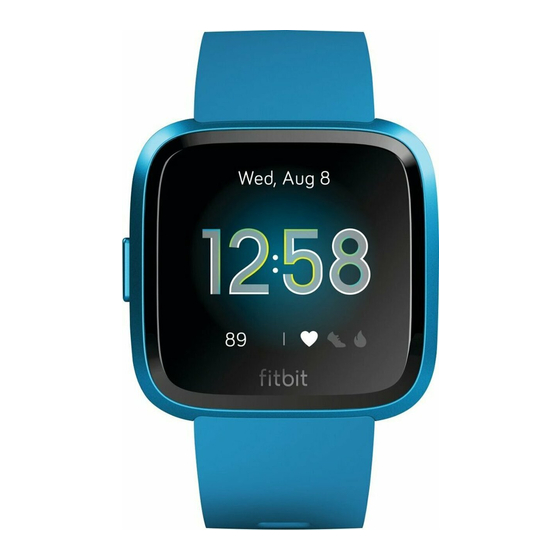Advertisement
Quick Links
How do I track my heart rate with my Fitbit device?
Track your heart rate continuously and automatically with your Fitbit device.
Skip to:
How does my Fitbit device detect my heart rate?
What are heart-rate zones?
What is resting heart rate?
How is resting heart rate measured?
What is max heart rate?
What factors impact my heart rate?
How do I improve the accuracy of my heart-rate reading?
What is my cardio fitness score in the Fitbit app?
How do I turn off heart-rate tracking on my Fitbit device?
Are the LEDs on my Fitbit device safe?
Why don't I see my heart rate on my Fitbit device?
How does my Fitbit device detect my heart rate?
When your heart beats, your capillaries expand and contract based on blood volume changes.
PurePulse LEDs (light-emitting diodes) on your Fitbit device reflect onto the skin to detect blood
volume changes, and finely-tuned algorithms are applied to measure heart rate automatically and
continuously. The heart-rate icon you see on the display tells you if you're in 1 of 3 heart-rate
zones.
What are heart-rate zones?
Heart-rate zones can help you optimize your workout by targeting different training intensities.
Fitbit calculates your maximum heart rate with the common formula of 220 minus your age.
Three heart-rate zones are determined using your estimated maximum heart rate. The
illustrations below provide examples for each zone.
Note that the icons may look slightly different between devices; for example, dots instead of
dashes. For more information about zones, see the American Heart Association's
Rates
article.
Peak zone
Peak zone means your heart rate is greater than 85% of its maximum. This high-intensity exercise zone is
for short, intense sessions that improve performance and speed.
FAQ
Target Heart
Advertisement

Summary of Contents for Fitbit Zip Versa
- Page 1 How do I track my heart rate with my Fitbit device? Track your heart rate continuously and automatically with your Fitbit device. Skip to: How does my Fitbit device detect my heart rate? What are heart-rate zones? What is resting heart rate? ...
- Page 2 On fitbit.com, log into your dashboard and click the gear icon > Settings > Personal Info, then enter your custom zone. Note that on Fitbit Ionic and Fitbit Versa, the heart-rate value appears gray if your watch is searching for a stronger reading.
- Page 3 What is resting heart rate? Resting heart rate measures your heart beats when you are still, and it can be an important indicator of the health of your heart. According to the American Heart Association website, “the average resting heart rate is 60-80 beats per minute, but it’s usually lower for physically fit people.”...
- Page 4 When you’re not exercising, wear your device a finger’s width above your wrist bone. Fitbit’s PurePulse technology is designed to be most accurate when you wear your device on the top of your wrist. For improved heart-rate accuracy, keep these tips in mind: 1.
- Page 5 To preserve battery life on your device, you can turn off heart-rate tracking. Note that the LEDs on the back of your device will continue to flash. Charge 3, Inspire HR, Ionic & Versa Open the Settings app > Heart Rate > Off ...
- Page 6 Fitbit friends. For Fitbit Ionic and Fitbit Versa, you're prompted to connect your watch to your Wi-Fi network. Ionic and Versa use Wi-Fi to set up your watch, download playlists, download apps from the Fitbit App Gallery, and for faster firmware and Fitbit OS updates. For best...
- Page 7 Fitbit friends. For Fitbit Ionic and Fitbit Versa, you're prompted to connect your watch to your Wi-Fi network. Ionic and Versa use Wi-Fi to set up your watch, download playlists, download apps from the Fitbit App Gallery, and for faster firmware and Fitbit OS updates.
- Page 8 Choose a link below depending on whether you prefer to use the Fitbit app or Fitbit Connect to set up your device. Fitbit App Fitbit Connect (Mac or Windows 8.1 computer) Fitbit App 1. Tap the Today tab , and tap your profile picture.
- Page 9 Which Devices Are Compatible With the Fitbit app? The following phones and tablets are fully compatible with Fitbit devices. We're continually adding more devices, so if you don't see your device here, check back soon. Apple devices iPhone XS Max iPhone 6S iPad Air iPhone XS iPhone 6 Plus...
- Page 10 Desire 816 One M7 One M8 One E8 One Max One M9 Huawei Ascend Mate 7 Honor 6X P20 Lite* Ascend P7 Honor 8 P20 Pro Honor 6 Mate 9 Honor 6 Plus *For more information about using the Fitbit app on your Huawei P20 Lite phone, see How do I use the Fitbit app on my Huawei P20 Lite phone? Lenovo Vibe X2...
- Page 11 Pantech - Vega Vega Iron 2 Vega Secret Note Samsung Galaxy S9+ Galaxy S5 Active Galaxy Note 5 Galaxy S9 Galaxy S5 Galaxy Note 4 Galaxy S8+ Galaxy S5 mini Galaxy Note III Round Galaxy S8 Galaxy S4 Active Galaxy Note III Galaxy S7 Edge Galaxy S4 Galaxy Alpha...
- Page 12 Windows 10 devices Microsoft Lumia 1520 Lumia 1320 Lumia Icon Lumia 1020 Lumia 950 XL Lumia 950 Lumia 930 Lumia 928 Lumia 925 Lumia 920 Lumia 830 Lumia 822 Lumia 820 Lumia 735 Lumia 730 Lumia 720 Lumia 650 Lumia 640 XL Lumia 640 Lumia 635 Lumia 630...
- Page 13 Xiaomi Mi 6...














Need help?
Do you have a question about the Versa and is the answer not in the manual?
Questions and answers